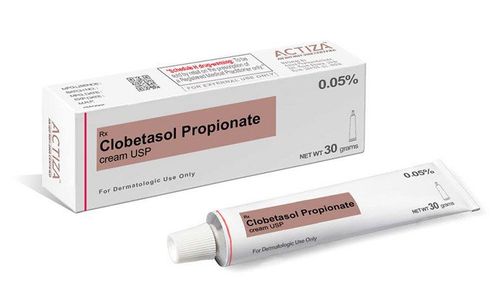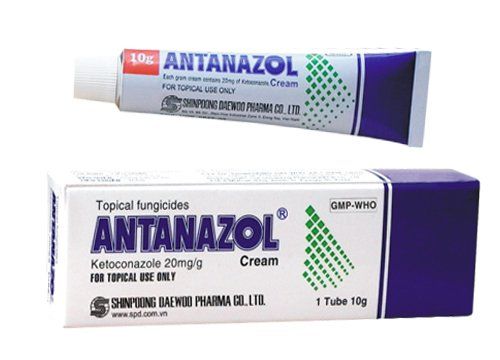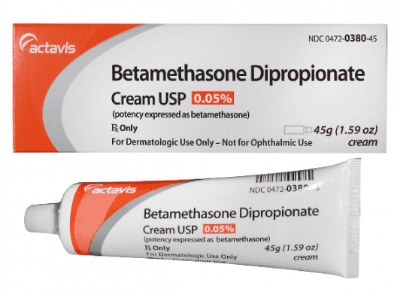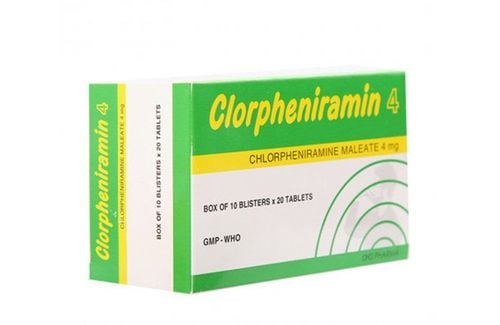This is an automatically translated article.
Atcobeta-N belongs to the list of antibacterial drugs with topical corticosteroids. The drug contains the main ingredients Betamethasone, Neomycin and Miconazole. Complying with indications, the dose of Atcobeta-N will help patients improve treatment efficiency and avoid unwanted side effects.
1. What is Atcobeta-N?
Atcobeta-N is available in the form of a topical ointment, packaged in tubes. Dosage form: Ointment
Pharmacodynamics:
Active ingredient Betamethasone valerate in Atcobeta-N is a corticosteroid with local anti-inflammatory and immunosuppressive properties. Like other steroid hormones, betamethasone valerate works in the body by controlling the level of protein synthesis. Meanwhile, the active ingredient Neomycin is antibacterial against sensitive bacteria (most gram-positive as well as gram-negative bacteria), neomycin has the ability to effectively treat infectious skin diseases.
Pharmacokinetics:
For the active ingredient Betamethasone:
Absorption: Betamethasone is easily absorbed when used topically. When applied, especially if the dressing is occlusive, when the skin is broken, or when rectal enema is applied, a sufficient amount of betamethasone may be absorbed for systemic effects. Distribution: Betamethasone is rapidly distributed into all body tissues. The drug may cross the placenta or be excreted in breast milk in small amounts. In the circulation, betamethasone can bind extensively to plasma proteins, mainly to globulins. Their half-life also tends to be longer, in fact, betamethasone is a long-acting glucocorticoid. Metabolism: Betamethasone is metabolized mainly in the liver and kidneys. The metabolism of betamethasone is slower and their protein binding affinity is lower. That may explain the stronger potency compared to natural corticosteroids. Elimination: Betamethasone is eliminated in the urine. For the active ingredient Neomycin:
Absorption: Neomycin can be absorbed increased when the mucosa is inflamed or damaged. Elimination: Neomycin is rapidly eliminated by the kidneys in the active form. The half-life of Neomycin is about 2 - 3 hours.
2. Uses and indications of Atcobeta-N
AtcoBeta-N is indicated for:
Treatment of inflammatory skin diseases that have responded to topical corticosteroids. Treatment of eczema, including: Baby eczema, atopic eczema, discoid eczema and stasis eczema. Treatment of itching, flaking, papules and contact dermatitis. Treatment of neurodermatitis, including: seborrheic dermatitis, lichen simplex, erythema, discoid lupus erythematosus, photodermatitis and insect bites.
3. Contraindications of Atcobeta-N
Atcobeta-N is contraindicated in the following cases:
People with a history of hypersensitivity to any ingredient or excipient of the drug. People who are suffering from skin lesions due to viral infections; Are suffering from acne ; Dermatitis around the mouth; People get otitis externa when the eardrum is perforated.
4. Instructions for taking Atcobeta-N
The patient thoroughly cleans the affected skin area, and at the same time washes his hands with soap and dries. Apply a small amount of Atcobeta-N to the affected area. Apply 2-3 times a day or follow the instructions of your doctor or pharmacist. Note: Atcobeta-N dosage above is for reference only. The specific dose of Atcobeta-N depends on the condition and the progression of the disease. To get the right dose of Atcobeta-N, patients should consult their doctor or healthcare professional.
How to handle missed dose, overdose Atcobeta-N:
In case of forgetting dose, Atcobeta-N should be supplemented as soon as possible. However, if it is almost time for the next dose, skip the missed dose of Atcobeta-N and use a new dose. When using Atcobeta-N in excess, it can cause hyperadrenocorticism. Patients need to stop the drug immediately and go to the nearest medical facility for timely treatment.
5. Undesirable effects of the drug Atcobeta-N
At therapeutic doses, Atcobeta-N is well tolerated. However, in the process of using Atcobeta-N, patients may still experience side effects such as:
Common, ADR > 1/100:
Hyperadrenocorticism. This side effect is common in infants and children, on the skin that is covered by the bandage. Uncommon, 1/1000 < ADR < 1/100:
Heat, itching, skin irritation and dryness; Folliculitis ; Hairy hair; Acne-like urticaria; Reduce pigmentation; Perioral dermatitis; Contact dermatitis ; Allergic dermatitis; Skin atrophy secondary infection; Skin rash; Millet in the skin. Rare, 1/10000 < ADR < 1/1000:
Pustular form. This is not a complete list of Atcobeta-N side effects. Therefore, if the patient notices any unusual signs of the body while taking Atcobeta-N, please inform the doctor for advice.
6. Notes when using Atcobeta-N
Corticosteroids will be absorbed more into the body if tcobeta-N is applied for a long time over a large area of the skin, in skin folds, on thin skin or in areas of skin that are under pressure (including wear dozen). This will increase the risk of local side effects such as skin thinning or systemic side effects such as decreased production of adrenal hormones. If possible, Atcobeta-N should not be used for a long time, especially in children. Atcobeta-N can only be used topically. If Atcobeta-N is used to treat psoriasis, it is necessary to monitor your health regularly. In case Atcobeta-N is used to treat psoriasis for a long time, it can make the disease worse and facilitate the transformation of pustular psoriasis after stopping the drug. Do not let Atcobeta-N come into contact with eyes, thin mucous membranes. If you accidentally get the medicine in your eyes, mouth and nose, you should immediately wash it with clean water. In case it is necessary to bandage the wound when using Atcobeta-N, it is necessary to clean the skin before dressing. When Atcobeta-N is indicated for use on children or the face, the compression technique (including diapering) should not be applied to the area to be treated. This may increase the absorption of Atcobeta-N into the body and lead to an increased risk of side effects. Wash your hands carefully after applying Atcobeta-N, unless your hands are on the skin to be treated. Do not use Atcobeta-N for longer than prescribed by your doctor, or for recurrent infections. Because it may cause the skin to become hypersensitive or allergic to the drug. If infection is widespread or symptoms do not improve after 7 days of treatment, consult your doctor about discontinuing Atcobeta-N and switching to oral administration. Do not dilute Atcobeta-N with wetting agents or any other mixture. Atcobeta-N should be used during pregnancy only when the potential benefit justifies the potential risk to the fetus. Atcobeta-N should not be used in large doses or for a long time in pregnant women. It is not known whether Atcobeta-N is absorbed into the bloodstream in sufficient amounts to be detectable in breast milk. However, caution should be exercised when Atcobeta-N is administered to a nursing woman.
7. Atcobeta-N drug interactions
There are no significant interactions when Atcobeta-N is co-administered with other products. However, when applying Atcobeta-N to large areas of the skin for a long time, the amount of active ingredient absorbed into the body may be enough to affect other medications being taken.
To avoid interactions, before being prescribed Atcobeta-N, the patient should inform the doctor about the drugs they are using, including functional foods. The doctor will base on that to prescribe the appropriate Atcobeta-N.
Above is all information about Atcobeta-N drug, patients need to carefully read the instructions for use, consult a doctor / pharmacist before using. Note, Atcobeta-N is a prescription drug, patients need to use the drug as prescribed by the doctor, absolutely do not self-treat at home.













